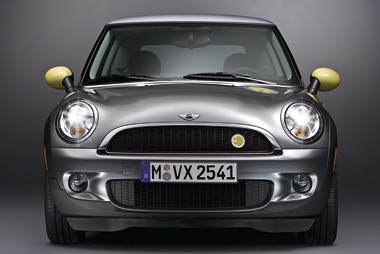Review
Remember those bicycles you had as a child, the ones where if you pedalled backwards the brakes came on? The Mini E prototype electric vehicle is a little like that.
Lift off the accelerator and the regenerative braking system kicks in and starts slowing the car down. With a bit of practice, the Mini E can be driven around without ever needing to hit the actual brakes. The brake lights come on automatically to alert other cars.
The regenerative system recharges the lithium-ion battery, helping to boost the car’s range. When the car’s charge, which is displayed below the speedo, runs below 20%, the battery will moderate the power output to eke out a few more miles.
Mini claims the E, which is already on trial in America, will typically run for 100-120 miles, although under “optimum conditions” it can reach 156 miles.
However, on a 35 mile A- and B-road test, our Mini E’s charge dropped to 44%, suggestion a range of just under 80 miles, some way off the expected figure. It underlines the concerns by consumers over the real-world range that can be achieved by electric vehicles.
Even Mini concedes that the range will be compromised by a multitude of external influences, such as using the radio or having the windows wound down.
BMW says the Mini E will never go into production. It is purely a test case to build up knowledge about driving habits and real world functionality in preparation for the launch of its mass production ‘Megacity’ family car within the next four years.
The Mini E goes on trial this month with 20 fleets and 20 members of the public who have volunteered to fork out the £330 monthly lease in order to act as a Mini E guinea-pig.
They have committed to drive the battery powered car for 300 miles a month to give BMW the feedback it requires for the next stage of electric vehicle development.
Each driver has agreed to have a mini wall box installed at their home with a 32-amp charge, which charges the car in 4.5 hours (a standard 13 amp takes 10 hours). They can also use one of up to 100 public charging points within the triangular test area (west London up to Oxford, down to Andover).
The 260kg battery pack sits where the rear seat bench would be, making these prototypes two-seater vehicles. It adds 220kg net to the weight of the car and alters the front-rear weight distribution from the usual 60:40 to 52:48.
Mini has stiffened the suspension and altered the DSC traction control system to take this additional payload into account.
The difference is noticeable, not least due to the sensitivity of the DSC, which is far too eager to kick in. It is at odds with Mini’s claim of offering an electric vehicle with the same fun factor as its standard models.
It’s a powerful battery, though, delivering 150kW and 220Nm of torque. The sprint to 62mph is a rapid 8.5secs and the top speed a limited 95mph. Unlike the Smart ED, whose power peaks from 0-30mph for city driving, the Mini E is intended for a range of driving requirements, including longer distance motoring.
There are plenty of unanswered questions about electric vehicles, such as range, battery life and whether to lease the battery. BMW hopes its Mini E trials will provide the answers.
Mini E
Engine Electric motor
Power 150kW, 22Nm torque
Weight 1,465kg
Performance 8.5s 0-62mph; 95mph top speed
Range 156 optimum; 100-120 usual
Battery Lition-ion, 35kWh
Charge 4.5 hours (32amp)
















Login to comment
Comments
No comments have been made yet.